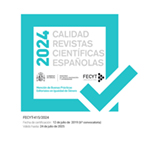Open Peer Review Vol.21 N.1
Raging Piggy: Fatphobia and Anger in Cerdita
Rebeca Maseda García
Section: Karpeta
Reviewer A:
Please, comment on the most relevant aspects (positive points and areas to improve) of the reviewed article.
The text provides a rich and well-founded analysis on the transformative gaze inherent in "Cerdita", a pioneering film in the Spanish context for addressing the issue of fatphobia through a movie that blends elements of horror and rape-revenge genres. The discussion of its belonging to these genres displayed in section 2 is extremely interesting. But the interest of the paper is further reinforced by the analysis of the rage experienced by marginalized groups and the emotional injustice they face, as explored in section 3. In the case of fat individuals, the most widely depicted emotion is humiliation. However, in "Cerdita," being the target of fatphobic bullying doesn't only lead to humiliation, but also to indignation and rage, drawing novel contours as subjects expressing anger, which is addressed in section 3. The discussion in section 4 of neoliberal affective rules and how they affect dissenting bodies is crucial. However, maybe it would be interesting to incorporate to the analysis of fatphobia as systemic, how under the neoliberal regime, social discourses urge fat individuals to diet and exercise, taking responsibility for their "health". In other words, they are not only encouraged to embrace their body diversity (which rarely represents non-normative bodies, e.g., the Dove advertising campaign that popularized the body positivity movement) but also to take charge of their health and appearance, leading to a proliferation of numerous dispositives by the medical and aesthetic industry. This aspect of fatphobia as a violent system that permeates the entire social body materializes within families as an active agent in fatphobic practices. The experienced violence often begins with mums urging children —especially girls, with a clear intersection between weight-based violence and sexism—to undergo diets and exercise. In the analysis of the violence exercised by the mother, it might be helpful to include references like Nina Navajas-Pertegaz (2021) or some of the works on fat activism that highlight the central role of family environments where violence is exercised "for their own good" leading to the early medicalization and pathologization of fat bodies (e.g., Contrera, 2019; Taylor, 2018; Piñeyro, 2016). Comparing it to "Psycho" is extremely suggestive, and the argument could be reinforced with these ideas coming from fat activism analysis. In section 5, in the debate with Martha Nussbaum about the productivity of anger, it may be necessary to more clearly argue the debate between retribution and recognition, especially because the issue of recognition is evident in fat activism, particularly through the concept of "depathologization", a dimension that links fat activism to crip theory and queer theory. In this context, it might be interesting to incorporate the contributions of Laura Silva (2021) on the efficacy of anger. Finally, the article presents solid conclusions. It is strongly recommended not to use the title of María Unanue's article within the text, as it may cause confusion since it is part of the title of Magdalena Piñeyro's book ("Stop gordofobia y las panzas subversivas"), from which the article published in Píkara is inspired.
Would you suggest any changes or make any recommendations to improve the quality of the article?
It is recommended to consider incorporating some references to expand the discussion in sections 4 and 5. The following bibliography is suggested for inclusion: Navajas-Pertegás, Nina (2021). «Deberías adelgazar, te lo digo porque te quiero: reflexiones autoetnográficas sobre la gordura». Athenea Digital, 21(1), e2434. Piñeyro, Magdalena (2016). Stop gordofobia y las panzas subversas. Málaga: Zambra. Silva, Laura Luz (2021). The Efficacy of Anger: Recognition and Retribution. In: Falcato, A., Graça da Silva, S. (eds) The Politics of Emotional Shockwaves . Palgrave Macmillan, Cham. https://doi.org/10.1007/978-3-030-56021-8_2 Taylor, Sonya Renee (2018). El cuerpo no es una disculpa. El poder del autoamor radical. Tenerife: Melusina
Reviewer B:
Please, comment on the most relevant aspects (positive points and areas to improve) of the reviewed article.
El artículo presenta un enfoque novedoso en la exploración de la rabia como elemento articulador, o no, de transformaciones a partir de discursos culturales como el audiovisual. Se indaga de manera productiva exploración de la gordofobia y de la violencia simbólica vinculada a ello. En el análisis de Cerdita se muestra como dicha violencia resulta el desencadenantes de la rabia de la protagonista. Uno de los puntos fuertes del artículo es el modo en el que mediante el análisis de la rabia se desvelan las consecuencias sociales y simbólicas de la ira de la protagonista en relación con el desafía de las reglas hegemónicas, neoliberales y postfeministas de la gubernamentalidad de los sentimientos. Esta ruptura se hace evidente en el desarrollo de lo que se denomina en el artículo disonancias afectivas y el consecuente proceso de la reimaginación y resaignación de la responsabilidad dela violencia infligida. En definitiva, se trata de un artículo bien diseñado desde el punto de vista metodológico que se ocupa de manera innovadora de analizar el impacto tanto discursivo como social de la rabia de las mujeres que sufren las consecuencias de la gordofobia.
Would you suggest any changes or make any recommendations to improve the quality of the article?
Quizá se podría desarrollar un poco más en la parte de análisis el argumento de bell hooks que se menciona al final de las conclusiones y que tiene que ver con la articulación del concepto de víctima en relación con el de agencia y, por tanto, con el carácter productivo o improductivo de la rabia.
The text included some modifications before publication












